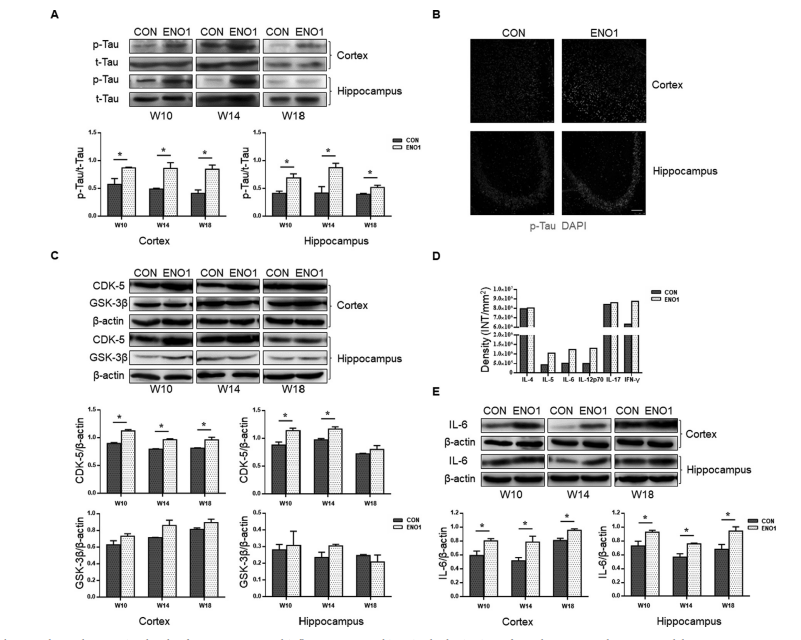Experimental evidence for alpha enolase as one potential autoantigen in the pathogenesis of both autoimmune thyroiditis and its related encephalopathy
Neurology; 神经科学; Autoimmunity; 自身免疫疾病; Encephalopathy; 脑病; Thyroiditis; 甲状腺炎; α-Enolase; α-烯醇酶; blood brain barrier; 血脑屏障; ENO1Ab; IgG deposit; IgG 沉积; Spatial learning; 空间学习; memory; 记忆;cell infiltration; 细胞浸润 LabEX支持文献- Int Immunopharmacol
- 5.714
- 85:106563
- mouse
- Elisa
- brain tissue
- 免疫/内分泌
- 自身免疫疾病
- IL-5, IL-6, IL-12
Abstract
Alpha-enolase (ENO1) is a ubiquitous protein. Patients with autoimmune thyroiditis-associated encephalopathy have high serum ENO1Ab titers. We aimed to explore whether ENO1Ab was the pathogenic antibody in the thyroid and brain. The serum ENO1Ab titers were significantly increased in the mice immunized with Thyroglobulin (Tg). And in the mice immunized with ENO1, serum levels of both TgAb and thyroid-stimulating hormone (TSH) were significantly increased. Obvious CD16+ cell infiltration, IgG deposit and cleaved caspase-3 were observed in the thyroid of ENO1-immunized mice. Spatial learning and memory abilities and synaptic functions were impaired in ENO1-immunized mice. Furthermore, the expression levels of Iba-1, GFAP, interlukin-6, CDK5, and phosphorylated tau were increased, and endothelial tight junction proteins were decreased in the brain of ENO1-immunized mice. These results suggest that ENO1Ab can cause thyrocyte damage via ADCC effect and impair cerebral function by disrupting the blood-brain barrier.
LabEx Luminex平台助力自身免疫性甲状腺炎的机制研究
本周为大家带来的文献为发表于Int Immunopharmacol. (IF: 5.6)的” Experimental evidence for alpha enolase as one potential autoantigen in the pathogenesis of both autoimmune thyroiditis and its related encephalopathy”。本文使用了LabEx提供的Luminex检测服务。
自身免疫性甲状腺炎是一种多因素紊乱疾病,其特征包括抗甲状腺炎抗体高表达和本地淋巴浸润。AIT相关脑病,也被称为桥本脑病(HE),是一种重要的甲状腺外自身免疫要素,其中有中枢神经系统损害和功能障碍参与。自身免疫性甲状腺炎的病人血清中ENO1Ab 滴度较高。本文旨在探讨ENO1Ab是否是甲状腺和大脑中的致病抗体。免疫甲状腺球蛋白(Tg)的小鼠血清中ENO1Ab滴度明显升高。免疫了ENO1的小鼠血清中TgAb和促甲状腺激素(TSH)的水平都明显升高。在ENO1免疫小鼠的甲状腺中观察到明显的CD16+细胞浸润、IgG沉积和caspase-3裂解。ENO1免疫小鼠的空间学习记忆能力和突触功能受损。此外,ENO1免疫小鼠脑中Iba-1、GFAP、interlukin-6、CDK5和磷酸化tau的表达水平升高,内皮紧密连接蛋白降低。这些结果表明,ENO1Ab可通过ADCC效应导致甲状腺细胞损伤,并通过破坏血脑屏障损害脑功能。
LabEx提供的Luminex检测服务:
蛋白芯片用于筛选W10时脑组织中细胞因子的产生。结果显示,ENO1组大脑皮层和海马组织匀浆上清液中IL-5、IL-6和IL-12的表达水平分别比CON组平均高2.41倍、2.39倍和2.61倍(图9D),而其他40种细胞因子的分泌似乎没有改变。

H-ENO1Ab小鼠模型脑组织中 p-Tau、CDK-5 和炎症细胞因子的表达水平升高。
重要发现:
ENO1在自身免疫性甲状腺炎中的作用:在实验性自身免疫性甲状腺炎(EAT)模型中,免疫小鼠的血清中ENO1特异性IgG及其四种亚型(IgG1、IgG2a、IgG2b、IgG3)显著增加,尤其是IgG2a和IgG1。ENOl免疫也导致血清甲状腺球蛋白抗体(TgAb)水平和甲状腺内单核细胞浸润评分显著增加。
异位抗原与自身免疫反应:研究发现甲状腺球蛋白(Tg)与ENO1具有10处同源性,暗示ENO1不仅作为甲状腺和脑组织之间的共同抗原,还可能通过表位模拟和分子间表位扩展在自身免疫反应中发挥作用。
高ENO1Ab小鼠模型研究:在高ENO1Ab小鼠模型中,血清ENO1特异性IgG及其亚型显著增加,脾脏中Th1/Th2和Th17/Treg细胞典型细胞因子的mRNA表达水平增加。特别是IL-4和IL-17A mRNA的表达与血清IgG亚型的分布一致。
甲状腺和脑组织损伤机制:在高ENO1Ab小鼠模型中,甲状腺组织中可见IgG沉积、CD16+细胞聚集和细胞凋亡增加,推测ENO1Ab可能通过抗体依赖的细胞介导细胞毒作用(ADCC)损伤甲状腺细胞,导致甲状腺激素分泌不足和促发其他甲状腺自身抗体的产生。
脑组织损伤与认知功能障碍:高ENO1Ab小鼠模型中,海马和皮质中过度磷酸化的Tau蛋白表达增加,伴随微血管周围水肿和血脑屏障(BBB)功能障碍,导致小胶质细胞和星形胶质细胞激活,促炎性细胞因子(如IL-6)表达增加,最终导致认知和行为损害。
潜在机制总结:ENO1Ab通过损伤脑微血管内皮细胞,导致BBB通透性增加,周围水肿,胶质细胞激活,脑内IL-6水平上调,CDK-5表达增加,Tau蛋白磷酸化增强,最终导致认知和行为功能障碍。
本网站销售的所有产品及服务均不得用于人类或动物之临床诊断或治疗,仅可用于工业或者科研等非医疗目的。







 沪公网安备31011502400759号
沪公网安备31011502400759号
 营业执照(三证合一)
营业执照(三证合一)


